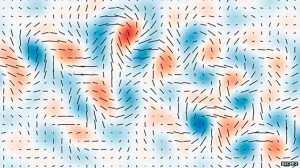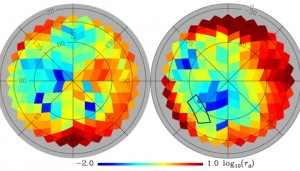A new analysis of Planck data provides the best measurements ever made of polarized dust emission across the sky — and bolsters the claim that the signal heralded as evidence for cosmic inflation is from dust instead.
Things are looking grim for the purported discovery of cosmic inflation’s fingerprints. Earlier this year, the BICEP2 team announced the detection of primordial B-modes, swirly polarization patterns imprinted on the cosmic microwave background (CMB) thanks to the hypothesized, split-second inflationary era. If inflation really did happen right after the universe’s birth, it should have spawned ripples in spacetime called gravitational waves, which in turn would have stretched and squeezed spacetime — and the plasma in it, ultimately fostering the creation of these polarization patterns in the CMB.

BICEP2
But other cosmologists quickly raised a red flag about BICEP2’s result, cautioning that the polarization detected might instead be from dust emission in the Milky Way itself. Irregular, charged dust grains interacting with our galaxy’s magnetic field can also produce the B-mode polarization patterns, and on the same angular scale as the theorized primordial ones.
Since the debate arose, the astronomy world has been waiting impatiently for the team of ESA’s Planck mission to cast the deciding vote. Planck’s all-sky CMB observations include polarization, and the mission’s researchers have been laboriously analyzing the data to separate the primordial signals from those originating closer to home. The team is being doubly careful because its preliminary data releases have inadvertently fueled the debate.
The galactic poles are the main regions of contention here. BICEP2 peered through the sparse galactic fog near the Milky Way’s south pole. More than a half dozen other B-mode experiments also focus on this Southern Hole. What everybody wants to know is, How much does dust emission contribute to the polarization signal in these galactic polar regions?
The Planck team has now released their preliminary analysis of the polarized dust emission near the galactic poles. The analysis doesn't include the detailed, multiple-frequency maps that will for certain settle the question, but it is still far and away the best measurement yet for this dust signal, says Planck scientist Charles Lawrence (JPL). What it shows is that dust is basically everywhere. "There is no escape from foregrounds, no part of the sky so clean that foregrounds can be ignored," Lawrence says.
Here's the punchline: the Planck team found that the strength of the dust signal is roughly of the same magnitude as the polarization signal reported by BICEP2.
No Final Answer Yet for B-modes
But we can’t write off the BICEP2 result just yet.

Planck Collaboration
First of all, the Planck analysis has sizable error bars, which the team is quick to point out. Second, there’s the ongoing issue of extrapolation. BICEP2 observed the CMB at a frequency of 150 GHz. The Planck analysis, on the other hand, uses 353-GHz data from the spacecraft’s High Frequency Instrument (HFI) and extrapolates down to what the emission should look like at 150 GHz. (See my detailed blog from June on why this is an important caveat.)
To do the extrapolation, the researchers used HFI data from 100, 143, and 217 GHz, as well as maps from various data subsets, to make sure they understood how the dust signal changes as they look at different frequencies. With this information in hand, they then took the 353-GHz data and created rough "150-GHz" maps based on how the dust signal's strength changes with frequency across the sky. The team stuck with 353 GHz instead of using the lower-frequency data to make the plots directly because at 353 GHz dust emission dominates over other polarization signals, meaning data at that frequency give the clearest picture of galactic dust.
The team stresses that the emission maps are estimates. But the analysis is exceptionally careful, and the results imply that polarized dust is the dominant signal in the BICEP2 field, says David Spergel (Princeton), who coauthored one of the cautionary analyses earlier this year. “There could be a weaker signal from gravitational waves, but I don’t think that the current data are good enough to separate out this weaker signal and make a statistically significant detection,” he sums up.
The Planck and BICEP2 teams are doing a joint analysis to get to the bottom of things. This analysis will hopefully be done in time for the big Planck conference in December, at which the Planck team will discuss the mission’s full temperature and polarization data (set to be released in November). These will include maps at all frequencies, Lawrence says, which will reveal features the averaging doesn't catch.
The new Planck analysis also picks out a few regions of sky that look the “cleanest” in terms of polarized dust emission. The largest region is, as expected, near the galactic south pole, as far from the dust-laden spiral disk as possible. Unfortunately, the BICEP2 field of view appears to have just missed the sweet spot. But other experiments — notably the Atacama B-mode Search (ABS) and the balloon-borne Suborbital Polarimeter for Inflation (SPIDER) — look right at it. (At least, if I’m doing my galactic-to-equatorial coordinate conversions correctly.)
Even if the BICEP2 result proves a gun-jumper, the experiment has helped to create the most sensitive polarization map for this sector of the sky, Spergel says. But it looks like it’s going to take even more sensitive measurements to discover primordial B-modes.
Reference: Planck Collaboration. “Planck intermediate results. XXX. The angular power spectrum of polarized dust emission at intermediate and high Galactic latitudes.” Posted to arXiv.org September 19, 2014.
Read more about primordial B-modes and the race to detect them in our October 2013 issue.
 1
1









Comments
Antonio Mario
September 26, 2014 at 10:30 pm
Dear Camille,
Thanks for a nice report.
With regards to a sentence in your second paragraph,
"Irregular, charged dust grains interacting with our galaxy’s magnetic field...",
strictly the grains don't have to be irregular but simply non-spherical (e.g., oblate like an aspirin or prolate like a pill). Also, they don't need to be charged to be aligned by the magnetic field of the Galaxy; it is the grains angular momentum that gets to be aligned along the magnetic field.
Thanks.
You must be logged in to post a comment.
You must be logged in to post a comment.